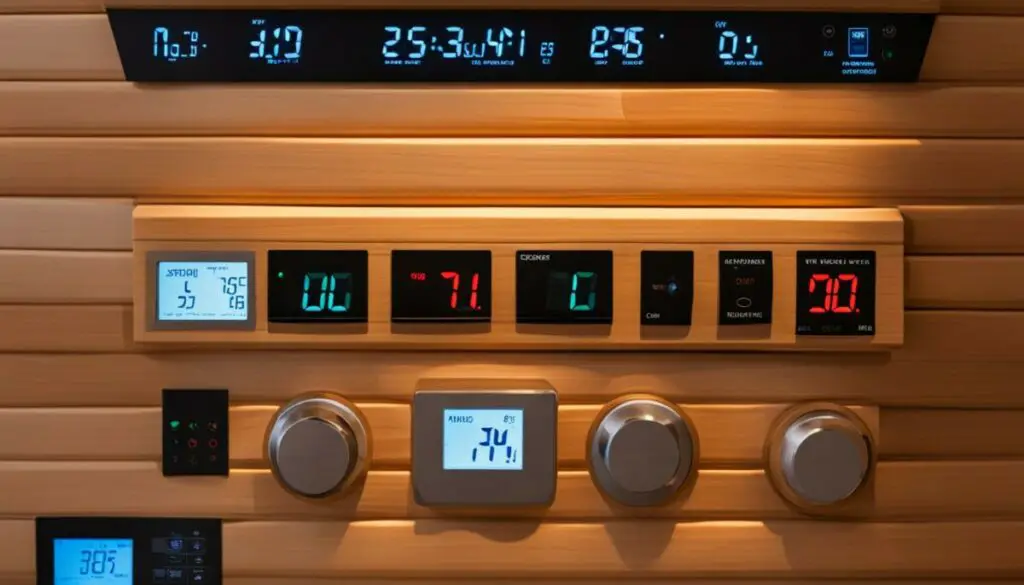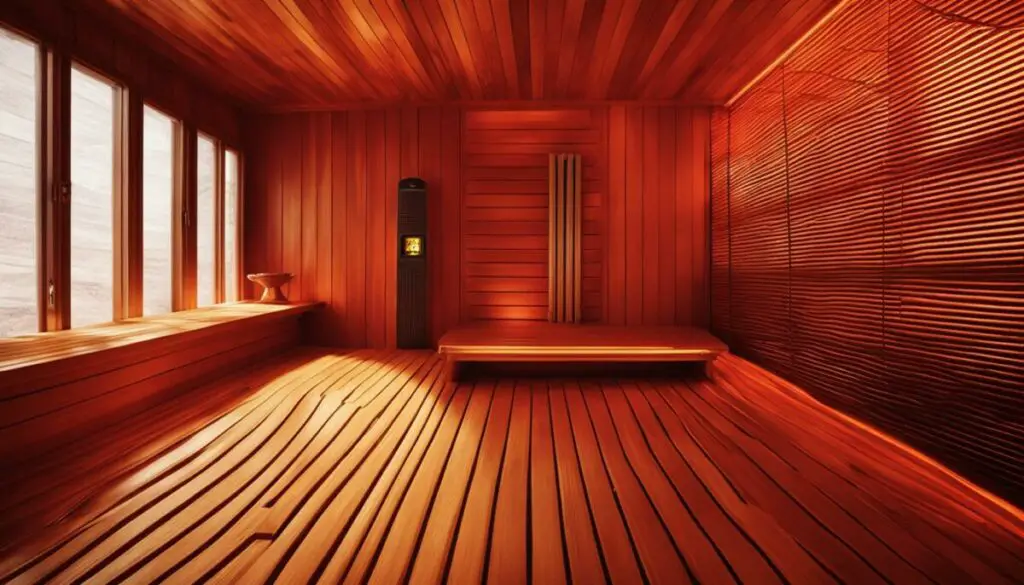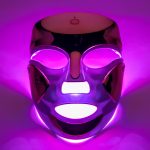Last Updated on 6 months by Francis
If you’re looking to switch up your wellness routine, an infrared sauna may be just what the doctor ordered. These saunas use infrared rays to heat the body, promoting circulation, relaxation, and other health benefits. But just how hot can an infrared sauna get?
Infrared saunas typically operate at lower temperatures than traditional saunas, making them a more comfortable and accessible option for those who can’t tolerate extremely high heat. But don’t let that fool you – infrared saunas can still get quite hot, reaching temperatures of up to 140°F or higher.
Whether you’re new to infrared saunas or a seasoned pro, understanding the maximum temperature of these units is essential to ensuring a safe and effective sauna experience. So, let’s dive deeper into the subject and explore the world of infrared sauna temperatures.
Contents
Key Takeaways:
- Infrared saunas can get quite hot, reaching temperatures of up to 140°F or higher.
- Understanding the maximum temperature of an infrared sauna is essential for a safe and effective sauna experience.
- Lower temperatures and adjustable heat settings make infrared saunas accessible to those who can’t tolerate extremely high heat.
Understanding Infrared Saunas and Their Health Benefits

Before delving into the specifics of infrared sauna temperatures, it’s important to understand what exactly an infrared sauna is and the many health benefits it provides. Infrared saunas use infrared heaters to emit radiant heat, which is absorbed directly into the body, rather than heating the surrounding air like traditional saunas. This unique form of therapy offers numerous benefits to both physical and mental health.
One significant advantage of infrared saunas is the ability to customize the temperature to suit individual preferences. The temperature range for infrared saunas typically falls between 120°F to 150°F, which is lower than the temperature range for traditional saunas. This lower temperature creates a more tolerable experience, allowing for longer sauna sessions and greater health benefits.
However, it’s essential to ensure that the sauna temperature remains within safe guidelines for a comfortable and enjoyable experience. The recommended safe temperature for an infrared sauna is between 120°F to 140°F, although some individuals may prefer a temperature range as low as 110°F to 120°F.
| Temperature Range | Maximum Recommended Time |
|---|---|
| 110°F – 120°F | 20 – 45 minutes |
| 120°F – 140°F | 20 – 30 minutes |
| 140°F – 150°F | 10 – 20 minutes |
It’s essential to monitor the temperature and duration of sauna sessions and to listen to your body’s signals. If at any point you feel too hot or uncomfortable, exit the sauna immediately and cool down with water and fresh air.
The health benefits of infrared saunas are numerous and include improved circulation, detoxification, pain relief, and stress reduction. By understanding the temperature range and safe temperature guidelines of infrared saunas, you can experience the many benefits of this innovative form of therapy while taking care to prioritize your well-being.
Exploring Infrared Sauna Heat Levels
When it comes to infrared saunas, heat levels are a crucial aspect of the sauna experience. Whether you prefer a mild or intense heat, understanding the various heat levels and settings available in an infrared sauna is essential in customizing your sauna session to meet your personal needs.
The heat levels in an infrared sauna are dependent on several factors such as the size of the sauna, the duration of the session, and the ambient temperature. However, it is important to note that the heat generated by infrared saunas is different from traditional saunas, and the temperature range therein is different as well.
| Infrared Sauna Heat Levels | Temperature Range (°F) |
|---|---|
| Low heat | 100-115°F |
| Moderate heat | 115-130°F |
| High heat | 130-145°F |
These are general ranges, and the actual temperature can vary depending on the individual’s preference and the sauna’s capabilities. Some infrared saunas also have specific heat settings, allowing for even more customization.
It is important to start with a lower heat level and gradually increase it to avoid any discomfort or overheating. Additionally, it is recommended to stay hydrated during your sauna session to prevent dehydration and regulate your body temperature.
Overall, understanding the different infrared sauna heat levels and settings available can help you achieve a comfortable and enjoyable sauna experience that meets your unique needs and preferences.
The Role of Temperature Control in Infrared Saunas

Temperature control is an essential feature of infrared saunas to ensure a comfortable and safe experience. Infrared saunas typically operate at lower temperatures than traditional saunas, which can range from 150-195°F. The recommended safe temperature for infrared saunas is between 120-150°F, making it suitable for a more extended session without the risk of overheating.
But how is temperature controlled in an infrared sauna? Most saunas come equipped with a control panel that allows you to adjust the heat intensity. The control panel may feature pre-set temperature options, such as “low,” “medium,” or “high,” or it may provide more precise temperature control, allowing you to increase or decrease the temperature by a few degrees.
It’s important to note that the size of your infrared sauna can also influence the temperature achieved. Smaller saunas tend to heat up more quickly, whereas larger saunas may take longer to reach the desired temperature. Similarly, the ambient temperature of the room can also play a role in infrared sauna temperature control. If the room is too cold, it may take longer to reach your desired temperature, while a warmer room may achieve the desired temperature more quickly.
Regular monitoring of the temperature during your sauna session is crucial for maintaining a safe and comfortable experience. You can use a thermometer to keep track of the temperature, and if you begin to feel uncomfortable or too hot, take a break or adjust the temperature settings. Listening to your body is essential to avoid pushing yourself beyond safe limits.
“Temperature control is an essential feature of infrared saunas to ensure a comfortable and safe experience.”
By understanding the role of temperature control in infrared saunas, you can maximize the benefits of your sauna experience while ensuring your safety and comfort. Remember to follow the safe temperature guidelines, monitor the temperature regularly, and adjust the settings as needed to maintain a comfortable temperature throughout your session.
Understanding Infrared Sauna Temperature Limits

When it comes to infrared saunas, temperatures can vary widely. However, it’s crucial to understand the temperature limits to avoid any potential health risks. Infrared saunas generally have a temperature range of 120°F to 150°F (48°C to 66°C), which is much lower than traditional saunas that can reach temperatures of 185°F (85°C).
It’s important to note that infrared saunas should never go above their maximum temperature limit, which is typically 150°F (66°C). Exceeding this temperature can result in dehydration, dizziness, and overheating, potentially leading to more severe health issues.
Infrared sauna manufacturers often provide explicit instructions on the maximum temperature and safe duration for sauna sessions. It’s essential to follow these guidelines to ensure a safe and beneficial experience.
It’s also important to understand your body’s response to heat and make adjustments to the temperature as necessary. If you feel lightheaded, dizzy, or uncomfortable, it’s crucial to take a break or lower the temperature and listen to your body’s signals.
Ultimately, the benefits of infrared saunas can only be fully experienced if used at safe and suitable temperatures. Understanding the temperature limits and adhering to them is crucial for a healthy and enjoyable sauna experience.
Health and Safety Considerations of Infrared Sauna Temperatures

While infrared saunas offer a plethora of health benefits, it’s crucial to prioritize safety when using them. Excessive heat exposure can lead to heat-related illnesses such as dehydration, heat exhaustion, and heatstroke. Thus, it’s essential to understand the safe temperature guidelines for your infrared sauna session.
The safe temperature range for an infrared sauna is between 120°F and 140°F. However, it is crucial to listen to your body’s signals and take necessary breaks when needed. If you feel uncomfortable or experience symptoms such as nausea, dizziness, or headaches, it’s time to step out of the sauna.
So, what is the highest temperature of an infrared sauna? That depends on the manufacturer and model of your sauna. Generally, the maximum temperature range of an infrared sauna is between 150°F and 170°F. However, it’s important to note that exceeding the safe temperature range can be detrimental to your health.
It’s crucial to maintain proper hydration during your sauna session to prevent the risk of dehydration. Drink plenty of water before, during, and after your session to replenish fluids lost through sweating. It’s also advisable to limit your sauna time to no more than 20-30 minutes per session to prevent overheating.
Remember to monitor the temperature throughout your session using the sauna’s control panel. If the temperature exceeds the safe range, it’s time to adjust the settings or end your session. Lastly, always consult with your doctor before using an infrared sauna if you have a pre-existing medical condition or are pregnant.
Factors Affecting Infrared Sauna Temperature

The temperature achieved in an infrared sauna can vary depending on several factors. Understanding these variables can help you customize your sauna session for optimal results. Some of the key factors that affect the infrared sauna temperature range and heat levels include:
| Factor | Description |
|---|---|
| Size of the sauna | The size of the sauna can influence the temperature range achieved. Larger saunas may require more time to heat up, but they can maintain a higher temperature for longer periods. |
| Duration of the session | The length of your sauna session can affect the temperature range you experience. A shorter session may not allow the sauna to reach its maximum temperature, while a longer session may increase the heat levels. |
| Ambient temperature | The temperature of the surrounding environment can affect the maximum temperature that the sauna can achieve. If the room is too cold, it may take longer for the sauna to heat up. Conversely, if the room is too warm, the sauna may not be able to reach its maximum temperature. |
By taking these factors into consideration, you can customize your sauna experience to suit your preferences and maximize the benefits of infrared sauna heat.
“It is important to note that the optimal temperature for an infrared sauna may vary depending on individual preferences and health conditions.”
Maximizing the Benefits of Infrared Sauna Heat

When it comes to infrared sauna sessions, understanding temperature control is crucial in order to reap the full benefits of the heat. The right temperature not only ensures a comfortable experience but also maximizes the positive effects on your health.
To achieve this, it’s important to know the maximum temperature of an infrared sauna and how to adjust it according to your individual needs. The safe temperature for an infrared sauna typically ranges from 120 to 150 degrees Fahrenheit, making it a comfortable and accessible option for most individuals.
During your session, maintaining proper hydration is essential to prevent dehydration and overheating due to the high temperature. Drinking water before and after your sauna session is recommended, and taking short breaks during the session to hydrate can also be beneficial.
Regular infrared sauna sessions are also key in maximizing the benefits of the heat. Consistency is important in order to achieve long-term health benefits such as improved circulation, reduced muscle tension, and enhanced relaxation.
By implementing these simple strategies, you can take full advantage of the heat levels of your infrared sauna, helping you achieve optimal wellness and relaxation. So sit back, relax, and let the heat work its magic!
Tips for Using an Infrared Sauna Safely
If you’re new to using an infrared sauna, it’s important to take precautions to ensure a safe and enjoyable experience. Keep in mind these safety tips to help you get the most out of your sauna session:
- Always start with a low temperature: It’s recommended to start at a lower temperature, around 100-130°F, and gradually increase the heat to a comfortable level.
- Stay hydrated: Be sure to drink plenty of water before and after your sauna session to prevent dehydration.
- Take breaks: It’s important to take a break if you start to feel lightheaded or overheated.
- Listen to your body: Pay attention to your body’s signals, and don’t push yourself too hard. If you feel uncomfortable, it’s time to end your session.
It’s also critical to be aware of the infrared sauna temperature limits. While infrared saunas can reach high temperatures, it’s essential to maintain a safe temperature range to avoid any potential health risks. The safe temperature for an infrared sauna is generally considered to be between 120-150°F. It’s essential not to exceed the infrared sauna temperature limits, which are typically around 150-170°F, depending on the specific sauna model.
By following these tips and being mindful of safe temperature guidelines, you can enjoy all the benefits of an infrared sauna while prioritizing your health and well-being.
Conclusion
Infrared saunas are a fantastic way to relax and enjoy a range of health benefits. By understanding the temperature range, limits, and safety considerations of infrared saunas, you can fully optimize your sauna experience. Remember to take breaks, stay hydrated, and monitor the temperature to ensure a safe and comfortable experience.
So, get ready to indulge in the soothing heat and relaxation of an infrared sauna, all while prioritizing your well-being. With the right temperature, proper hydration, and regular sauna sessions, you can maximize the numerous health benefits that infrared saunas provide.
FAQ
How hot can an infrared sauna get?
An infrared sauna can reach temperatures ranging from 120°F to 150°F (49°C to 66°C), depending on the model and personal preference.
What is the maximum temperature of an infrared sauna?
The maximum temperature of an infrared sauna can vary, but it typically does not exceed 150°F (66°C) to ensure a safe and comfortable experience.
What is the temperature range of an infrared sauna?
Infrared saunas usually have a temperature range of 120°F to 150°F (49°C to 66°C), allowing you to adjust the heat intensity according to your preferences and comfort level.
How do I control the temperature in an infrared sauna?
Most infrared saunas come with temperature control settings that allow you to adjust the heat levels. These settings can be easily accessed and modified using the sauna’s control panel.
What are the safe temperature guidelines for an infrared sauna?
It is generally recommended to keep the temperature in an infrared sauna between 120°F and 150°F (49°C to 66°C) to ensure a safe and comfortable experience. However, it’s essential to listen to your body and adjust the temperature based on your individual tolerance.
Can infrared sauna temperatures be harmful?
While infrared saunas offer numerous health benefits, excessive heat exposure can be harmful. It is important to adhere to safe temperature guidelines and consult with a healthcare professional if you have any concerns or underlying health conditions.
What factors can affect the temperature in an infrared sauna?
The temperature in an infrared sauna can be influenced by various factors, including the size of the sauna, the duration of the session, and the ambient temperature. These variables can impact the heat intensity and your overall sauna experience.
How can I maximize the benefits of infrared sauna heat?
To maximize the benefits of infrared sauna heat, it is important to find a temperature that is comfortable for you, stay properly hydrated before and after each session, and incorporate regular sauna sessions into your wellness routine.
What are some tips for using an infrared sauna safely?
When using an infrared sauna, it is important to monitor the temperature, take breaks if needed, and listen to your body’s signals. Stay hydrated throughout your sauna session and follow any specific safety instructions provided by the sauna manufacturer.
How can I prioritize my well-being while using an infrared sauna?
Prioritizing your well-being while using an infrared sauna involves understanding the temperature range and limits, following safe usage guidelines, taking care of your hydration needs, and being mindful of your body’s response to the heat. Always consult a healthcare professional if you have any health concerns or questions.





.jpg)



